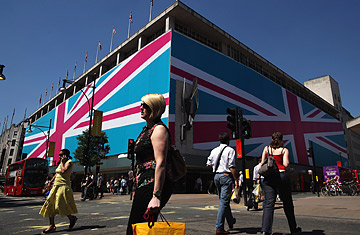
LONDON, ENGLAND - JULY 24: Members of the public walk past the John Lewis department store, where a giant Union Flag adorns it's facades, on Oxford Street on July 24, 2012 in London, England. London is gearing up with only 3 days remaining until the opening ceremony of the 2012 London Olympic games.
(2 of 2)
As a result, a typical John Lewis sales floor feels "more like a family" than a cutthroat retailer, explains Elizabeth Dunbar, a John Lewis stock auditor. "We are protective of each other and protective of the business." No wonder. In addition to granting hefty annual bonuses, the company owns and operates five resort hotels for its employees' use, including Brownsea Castle, a 16th century edifice with a private beach on an island off England's southern coast. Employees have the run of subsidized vacations (wine-tasting excursions to France, for instance); hobbyist clubs around the country for a range of activities including skiing, snowboarding, sailing and horseback riding; and half-price tuition for classes in, say, Renaissance architecture or Japanese cooking.
The cushiness comes at a cost. Last year the company spent about $588 million on such benefits, which is more than twice what rival Marks & Spencer spent on benefits for its 82,000 employees over that period. The upside for John Lewis is low staff turnover. Employee churn, which averages around 40% to 50% in the retail industry, is only 20% at John Lewis. "That's obviously a cost savings," says Joshua Bamfield, director of Britain's Centre for Retail Research. The company also keeps layoffs to a minimum, even during downturns, by offering to retrain and redeploy most partners whose jobs get cut. That kind of security, coupled with the ownership glow and perks, imbues employees with a passion for their job and a devotion to their customers, says Lisa Byfield-Green, an analyst with London consultants Planet Retail. And Retail Expertise's Poynor estimates that John Lewis spends at least 25% more than its rivals on staff development, and it shows: some 80% of its sales are to 20% of its most loyal customers.
Of course, the model isn't a fix-all. Partnerships tend to work best for small- to medium-size companies. John Lewis' recent expansion abroad could fail if the cultural advantages are lost on foreign franchisers. Unlike with publicly traded firms, employee-owned companies are also less regulated, which can make raising outside capital harder, since banks and bond buyers have less data to assess risk. "That can lead to a lack of scrutiny that can be disastrous," says Bang Dang Nguyen, a finance lecturer at Cambridge University's Judge Business School. Take Arthur Andersen, the major employee-owned accounting firm that tanked in 2002 after a few bad seeds helped Enron hide its losses.
Still, investors in employee-run firms tend to be more patient about returns. And employees are often better stewards of a founder's vision than outsiders. John Lewis employees overruled a push to sell the company to outside investors in 1999 — which promised a windfall payout of roughly $150,000 per employee — fearing that cutbacks by any new owner would squelch company culture. "Since that wobble," says Poynor, "the business has gone from strength to strength."
Only 3% of British businesses are employee owned, compared with 10% in the U.S. But Britain's numbers could grow by about 10% this year, adding another 100 companies, according to Iain Hasdell, CEO of the Employee Ownership Association in London. As the country's public coffers dwindle, sluggish government agencies that have gone private, like the Royal Mail and elder-care providers, are the likeliest contenders.
The John Lewis economy is on prominent display at the London Olympics. The company has a large department store in the Westfield Stratford City mall in East London, which abuts the Olympic stadium. To accommodate the rush of business accompanying the Games, the store's employees are willingly working later, keeping the store open till 10 p.m. most nights, two hours later than usual. With its shops filled with London 2012 souvenirs and trinkets, sales of gift items are already up 60% over last year. True to John Lewis' mid-market ethos, the range is high to low. Can't afford $4,464 for a commemorative gold coin from the Royal Mint? Grab a minireplica of the Olympic torch — a steal at $15.50.
